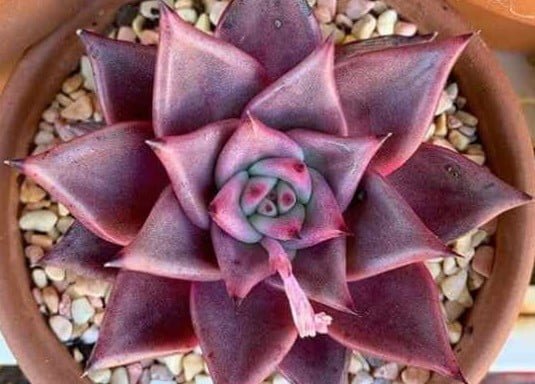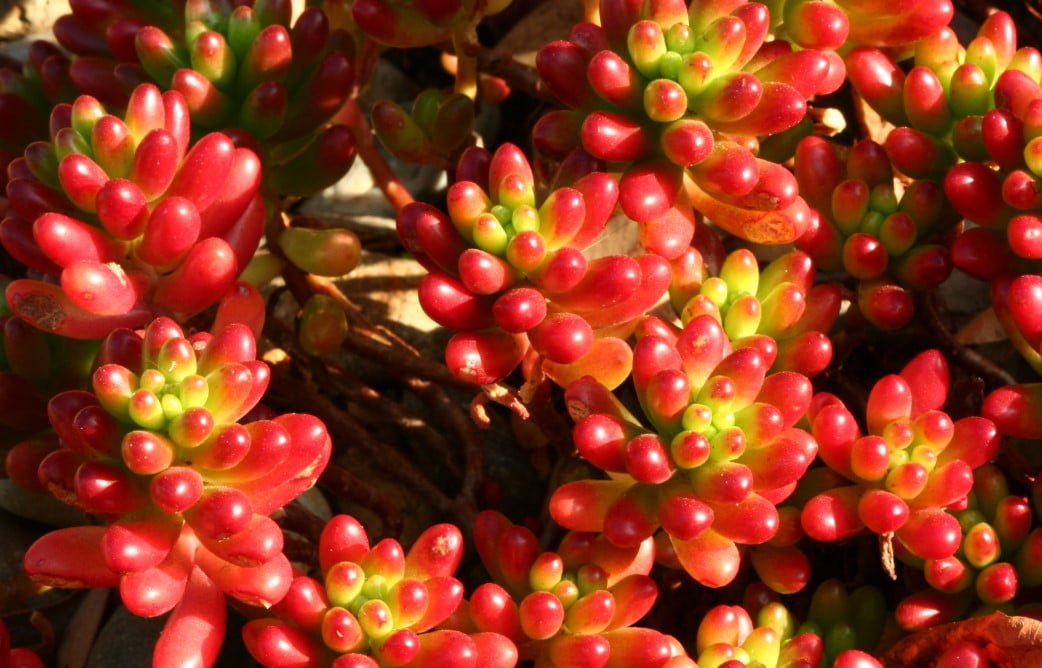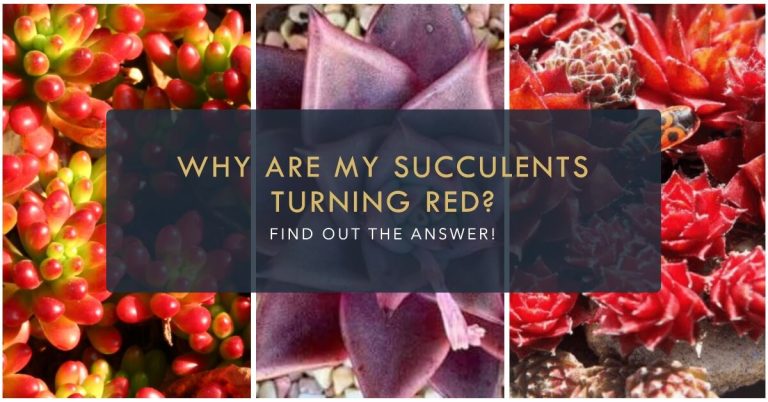Why Are My Succulents Turning Red? – Are you a succulent enthusiast? You may have noticed that your beloved succulents are turning red. This is a common and natural occurrence for many succulent plants, and several factors can cause this vibrant change in color.
Direct sunlight exposure is one of the most common reasons your succulents are turning red. Succulents love bright, indirect light, and too much exposure to the sun can cause the leaves to turn a deep shade of red. On the other hand, if your succulent isn’t receiving enough light, it will also begin to turn colors as it struggles to survive.
Another factor affecting your succulents’ color is poor soil or lack of water. Succulents need well-draining soil with plenty of air pockets to thrive and stay healthy. If they don’t receive adequate water, they will start to wilt, and their bright green color will fade into a dark red hue.
Finally, extreme conditions such as cold temperatures or extended periods of extreme heat can also cause stress in your succulents, leading them to turn colors such as yellow, orange, or even red. To ensure healthy and colorful succulents all year, provide them with adequate water and bright light without exposing them to extreme conditions.
Sunlight Requirements for Succulents
If you want to keep your succulents happy and healthy, one of the most important things to remember is to provide them with the right amount of sunlight. Too much sun can cause leaves to wilt, while too little can prevent your succulent from achieving its vibrant colors.
When it comes to light requirements, there are several factors that come into play. The type of succulent you have, where it’s located, and even the season all affect how much direct sunlight your plant should receive. Most succulent varieties require at least four hours of bright but indirect light daily. If you want your plant to achieve its maximum potential, try placing it near a south-facing window or moving it outdoors during the summer months.
It’s also important to remember that some succulents, such as Aloe Vera or Haworthia, are more sensitive than others regarding sunlight exposure. If you notice any signs of stress, such as wilting or discoloration in the leaves, move your plant away from direct sunlight immediately and provide some shade for a few days before returning them to brighter light conditions.

Direct Sunlight
Direct sunlight is the key to achieving vibrant colors in succulents! While some varieties of succulents require more light than others, most need at least four hours of bright but indirect light each day.
The best way to achieve this is by placing your plants near a south-facing window or outdoors during summer. But be careful not to overexpose your succulents to direct sunlight! Too much sun exposure can lead to wilting and discoloration in the leaves.
If you notice any signs of stress, remove your plant from direct sunlight immediately and provide shade for a few days before returning them to brighter light conditions. So go ahead and let those beautiful succulents soak up the sun – remember to keep an eye on them and adjust accordingly for their optimal health!
Bright Light and Colorful Succulents
Colorful succulents are the perfect way to brighten up any space! With their vibrant hues, they can make a statement in any room. The key to achieving those beautiful colors is by giving your plants plenty of bright light.
While most succulent varieties need at least four hours of indirect sunlight per day, you’ll want to pay close attention to how long and how much direct sunlight your plants get as this can cause them to become stressed and discolored if overexposed.
Experiment with different light levels until you find the perfect balance for your succulents!
Extending the Amount of Sun Exposure Safely
When bringing out the vibrant colors of succulents, sun exposure is key. But how much should you give your plants? The answer is simple: just enough! Too much direct sunlight can cause leaf scorching or even death in extreme cases.
So if you’re looking to safely extend the amount of sun exposure, here’s what you need to do. Start by gradually increasing the hours of direct sunlight each day until your succulents reach their desired level of color.
Then, monitor them closely and shade them when needed – think twice before going overboard on those sunny days!

Understanding Stress in Succulents
Stress in succulents can be a tricky thing to understand. The bright colors of succulents are often a result of stress that the plant has endured, whether it’s from too much sun or lack of water.
But, what if you could use this stress to your advantage? You can help bring out the most colorful hues in your beloved plants with a few simple tips! For starters, ensure they have plenty of indirect light and don’t over-water them – succulents need just the right amount of moisture and nutrients.
Additionally, try potting them into larger containers to avoid root-bound succulents, which can suffer from poor soil conditions. Finally, don’t forget to give them some breaks now and then – an extended period in bright sunlight will bring out their most vibrant colors while giving them a chance to rest and rejuvenate.
Soil Requirements for Succulent Plants
Soil is the foundation of any succulent plant’s health, and those looking to cultivate their miniature oases should get the right mix. Succulents don’t like to be bogged down – they need soil that drains quickly in order to prevent root rot.
That means you should look for a light, airy medium with plenty of sand or perlite added. You can also add a slow-release fertilizer or other organic matter for extra nutrients, but remember that too much of this can make your soil heavy and water-logged.
Finally, no matter what type of soil you settle on for your succulent collection, it’s best to give them a good soak before adding them in – make sure not to do it too often!
Poor Soil Conditions and Their Impact on Color
Poor soil conditions can be the ultimate mood killer when it comes to vibrant and colorful succulents. If your succulents are not getting the right nutrients, they could turn a dull red or even yellow shade.
This is because the lack of essential vitamins and minerals in the soil can hinder their ability to produce healthy, green foliage. Additionally, if your succulent is exposed to direct sunlight for an extended period without sufficient water, its leaves may change color due to sunburn or dehydration. To keep your succulents looking their best and brightest, give them optimal care and attention – including the right soil!

Watering Tips for Healthy Plants
Watering your succulents correctly is key to keeping them healthy and vibrant. Too much water can be just as bad as too little, so finding the right balance is important. You should water your succulents deeply but only a few times for optimal health.
A good rule of thumb is to wait until the top two inches of soil have dried out before watering again. Additionally, if you’re growing succulents in a pot or container, it’s best to use one with drainage holes so that excess water can escape easily.
Root-Bound Succulents and the Impact on Color
Root-bound plants may turn red, yellow, or even black if left unchecked. This occurs when the plant’s roots become cramped and unable to absorb enough water or nutrients from the soil.
To ensure your succulents stay vibrant and colorful, it’s important to check for signs of root-binding occasionally. If you notice your plants becoming root-bound, immediately repot them into a larger container with fresh soil. Doing this will give the plant more room to grow and prevent its colors from fading!
Extreme Temperatures That Affect Color Change in Succulents
Regarding succulents, extreme temperatures can be their worst enemy in maintaining their vibrant colors. Too much sun exposure or cold temperatures can cause the leaves of succulents to turn red or yellow.
The same goes for extended periods of heat and bright light, which can also cause the succulent’s green color to fade away. To keep your succulents looking their best and maintain their bright colors, ensure you provide them with enough water and shade during periods of extreme weather.
Additionally, pay attention to the soil they’re planted in – if it’s too poor in quality, your succulents won’t have access to the necessary nutrients they need to stay healthy and colorful!
Cold Temperatures and Color Changes in Leaves
Unsurprisingly, cold weather can take its toll on succulents, especially regarding the color of their leaves. While it’s true that too much sun exposure or extreme temperatures can cause the leaves of succulents to turn red or yellow, cold temperatures are also a culprit behind oddly-colored leaves.
When exposed to freezing conditions for an extended period, succulent leaves can become discolored, often turning shades of pink or purple. To ensure that your beloved plants don’t suffer from this kind of stress, keep them warm and away from drafts. Additionally, check on them regularly and water them when necessary – even during winter!
How Much Heat is Too Much Heat?
Heat is important for succulents, as it helps them grow and thrive. However, too much heat can damage these plants, leading to various issues such as wilting leaves and discolored foliage. To keep your succulents healthy, providing them with the right amount of heat and light is important.
Too little sunlight can cause the plant to become weak and pale, while too much direct sunlight will cause bright colors to fade or even burn the leaves. Additionally, extreme temperatures can cause stress in succulents, resulting in leaves that turn red or yellow. To prevent this, keep your plants away from heat sources like radiators or air conditioners and ensure they can access plenty of water.
Lack of Water and Its Effects on Color Change in Succulents
Do you have a succulent that is changing color? While many factors can cause the leaves to turn red or yellow, one of the most common culprits is lack of water. Succulents require regular watering to stay healthy and vibrant, but their leaves can take on a dull hue when deprived of this essential element for an extended period.
This is because as plants dry out, their cells become less efficient at carrying nutrients and producing pigments needed for green foliage. To keep your succulent looking its best, ensure it’s getting enough water and bright light—especially during extreme heat or cold periods.
Conclusion Why Are My Succulents Turning Red
It’s easy to keep your succulent looking its best! You only need plenty of water, bright light, and proper care. Too much or too little sun exposure can cause the leaves to turn red or yellow, but with the right amount of light and regular watering, you can help maintain vibrant colors in your plant. Additionally, ensure your succulent isn’t root-bound or stressed from extreme conditions.
